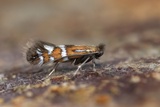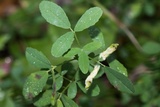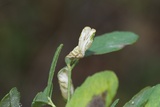Phyllonorycter nigrescentella (Logan, 1851) Species
Last modified: Dec. 14, 2024, 4:25 p.m.
A very local and very rare species in Belgium, occurring almost exclusively in the limestone Calestienne area.
Details
- Classification
- Family: Gracillariidae > Subfamily: Lithocolletinae > Genus: Phyllonorycter > Species: Phyllonorycter nigrescentella
- Vernacular names
- Tentjes-klavervouwmot (NL), Vetch midget (EN)
- Synonyms
- Phyllonorycter bremiella (Frey, 1855)
- First mention in Belgium
- Fologne E. 1862a. Notes d'une excursion à Fondeleffe, près de Dinant. — Annales de la Société entomologique belge 6: 23–25. On page 24 (as bremiella). view page
- Status
-
Native
Distribution
Imago
Head dark brown; forewing ground colour brown; white pattern consisting of a rather short basal line, finely edged with dark brown scales; a patch of white scales in the basal area of the dorsum, one transverse band edges with dark brown scales on both sides, three costal and two dorsal striae also edged on both sides with dark brown scales; a small patch of very dark brown to blackish scales in the apical area.
Caterpillar
The caterpillars are intensely yellow with a greenish translucent intestinal canal and a light brown head.
Mine
A tentiform mine on the underside of a leaf, strongly inflated and almost folding the entire leaflet. Some longitudinal folds on the underside. The upper surface is mottled white in the beginning but turns purplish brown at a later stage and affected plants become very obvious.
See also gracillariidae.net and bladmineerders.be.
Cocoon/pupa
A very flimsy cocoon consisting of just some spun threads. Pupa light brown.
Bionomics
The last instar pupates inside the flimsy cocoon. Ph. nigrescentella is one of those species that does not pupate in the fall, but rather overwinters as caterpillars that are ready to pupate. However, it is mentioned several times in the literature that the pupa should also hibernate.
Flight periods
Two generations a year in April/May and August/September.
Observed on
- Host plant (species):
- Vicia sepium
In Belgium, the mines are most of the time found on Vicia sepium. The species has also been recorded on other plants, like Lathyrus, Lotus, Medicago and Trifolium.
Habitat
Limestone areas where the larval host plant grows in the shade of higher vegetation or under trees.



